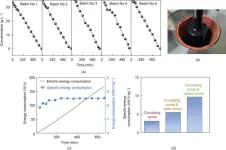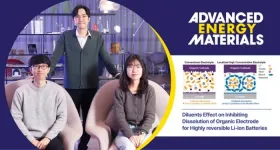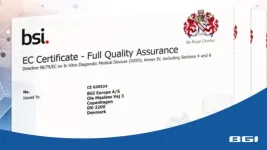(Press-News.org) FOR IMMEDIATE RELEASE
Drugs that target a receptor on immune cells called activin receptor 1C may combat tumor-induced immune suppression and help patients’ immune systems fight back against cancer, according to a study by investigators at the Johns Hopkins Kimmel Cancer Center and its Bloomberg~Kimmel Institute for Cancer Immunotherapy.
The study, published online Jan. 8 in Oncoimmunology, identifies a new strategy cancer cells use to protect themselves from immune system attack, and suggests treatments that could counteract it. It shows that tumor cells and some immune cells produce proteins called activins that cause immune cells called CD4+ T helper cells — which send signals to other immune cells to destroy infectious particles — to transform into another type of T cell (regulatory T-cells, or Tregs), which performs the opposite function, suppressing immune system activity. However, blocking activin receptor 1C on CD4+ T cells helps prevent the accumulation of immune-suppressing Tregs in tumors and slows tumor growth.
“We have identified a new target for anticancer immunotherapy,” says the study’s senior investigator, Drew Pardoll, M.D., P.h.D., director of the Bloomberg~Kimmel Institute for Cancer Immunotherapy and professor of oncology at the Johns Hopkins University School of Medicine. “Our discovery could lead to an entirely new class of immunotherapies that may enhance the effects of existing cancer therapies and further personalize cancer care.”
Tregs are essential in preventing the immune system from attacking the body’s cells and causing autoimmune diseases. But tumors co-opt this normally protective cell to defend themselves against destruction by the immune system, suppressing the body’s built-in defenses to cancer. Patients with more Tregs have worse cancer outcomes, but studies in mice have shown that blocking Tregs inhibits tumor growth, and reducing Treg numbers causes tumors to shrink.
About a decade of research by Johns Hopkins researchers on the role of a transcription factor called YAP in Treg production in tumor cells led to the discovery that YAP boosts activin receptor 1C numbers on Tregs. The fact that this receptor only occurs on cells produced in the bone marrow, such as immune or blood cells, reduces the likelihood of harmful off-target effects.
In the study, the investigators demonstrated that mice genetically engineered to lack the activin receptor 1C are healthy, able to reproduce and naturally resistant to tumor growth. Treating mice with an antibody that blocks the receptor also had anticancer effects. When combined with antibodies to a second inhibitory immune receptor, PD-1, which are used clinically to treat many cancers, the antibody had an even greater impact on tumors, even those that do not usually respond to anti-PD-1 therapies.
Because the human activin receptor 1C is almost identical to the mouse activin receptor 1C, Pardoll is hopeful that similar efficacy will be achieved in humans. The similarity will also help expedite preclinical studies testing anti-activin receptor 1C antibody therapy candidates. Pardoll and colleagues are partnering with Immunomic Therapeutics to develop several potential candidate antibodies.
“We hope to have an antibody available for clinical trials in 2025,” he says.
If clinical trials are successful, the anti-activin receptor 1C antibodies could be a potent addition to the arsenal of anticancer drugs. Combining them with PD-1 inhibitors could improve treatment effectiveness. Pardoll explains that blood tests can identify patients with high levels of activin who may be more likely to benefit from anti-activin receptor 1C antibody therapies, allowing more precise identification of patients likely to benefit from the therapy.
Study co-authors were Ying Zheng, Andriana Lebid, Liam Chung, Juan Fu, Xiaoxu Wang, Andrea Otrocol, Jelani C. Zarif, Hong Yu and Nicolas J. Llosa of Johns Hopkins.
The study was supported by the Bloomberg~Kimmel Institute for Cancer Immunotherapy fund at the Johns Hopkins University School of Medicine.
Zheng, Lebid, Fu and Pardoll are named on a patent related to this work and are eligible for royalties. These relationships are managed by The Johns Hopkins University in accordance with its conflict-of-interest policies.
END
Immune cell receptor provides promising immunotherapy target
2024-02-22
ELSE PRESS RELEASES FROM THIS DATE:
Silicon microresonators for artificial neural networks
2024-02-22
Researchers have made significant progress in the development of artificial neural networks using tiny silicon devices called microresonators, paving the way for faster and more energy-efficient artificial intelligence systems. These networks mimic the computing capabilities of the human brain, breaking away from traditional digital computer architectures and leveraging the speed, low power dissipation and multi-wavelength capabilities of photonics.
A review article describing the implementations of neural networks using silicon microresonators was published Jan. 16 in Intelligent Computing, a Science Partner Journal.
Silicon microresonators ...
Scientists develop a simple blood test to quickly diagnose sarcoidosis
2024-02-22
Scientists develop a simple blood test to quickly diagnose sarcoidosis
NIH-funded tool can accurately identify the potentially life-threatening inflammatory disease
A research project supported by the National Institutes of Health has developed a tool to rapidly and inexpensively diagnose sarcoidosis, a chronic inflammatory disease marked by the growth of tiny lumps called granulomas in the lungs and other organs in the body. The tool, which uses a simple blood test, could allow for selective use of more invasive diagnostic tests often used to identify the ...
New electrochemical system enables efficient metal recovery from industrial wastewater
2024-02-22
A research team at Tsinghua University led by Professor Huijuan Liu has developed a new electrochemical system that promises to revolutionize metal recovery from industrial wastewater. The research was published in Engineering.
Industrial wastewater poses significant environmental hazards due to heavy metal pollution. Current methods for metal recovery, such as electrodeposition, suffer from interfacial ion transport limitations, resulting in slow and low-quality recovery. In their study, the team proposed a novel approach that integrates a transient electric field (TE) and swirling flow (SF) to improve mass transfer and promote interfacial ...
Non-solvating electrolytes enhance performance of organic electrode-based batteries
2024-02-22
In a groundbreaking study, Professor Won-Jin Kwak in the School of Energy and Chemical Engineering at UNIST, in collaboration with researchers from Hanyang University, have pioneered a method to significantly enhance the performance and lifespan of organic electrode-based batteries. The findings promise to accelerate the commercialization of eco-friendly batteries and pave the way for further advancements in the field.
Organic electrodes have long been recognized for their cost-effectiveness and natural abundance, making them a promising alternative to traditional lithium-ion battery ...
NIFTY® DNBSEQ-G99 platform receives CE-IVDD certification and advances prenatal care standards
2024-02-22
BGI Europe A/S, a wholly owned subsidiary of BGI Genomics, announced its NIFTY® non-invasive prenatal testing kit and software (CE-IVDD List B) were granted an extension under its existing CE-IVDD certification to include the DNBSEQ-G99 model to meet the European Union regulations for medical devices.
In January 2024, BGI Genomics unveiled the NIFTY® ultra-fast non-invasive prenatal genetic testing product, utilizing the innovative DNBSEQ-G99 platform. Designed for both small and medium throughput, this platform ensures top-notch testing ...
Living in violent neighborhoods affects children's brain development
2024-02-22
Living in neighborhoods with high levels of violence can affect children’s development by changing the way that a part of the brain detects and responds to potential threats, potentially leading to poorer mental health and other negative outcomes, according to research published by the American Psychological Association.
However, nurturing parents can help protect kids against these detrimental effects, according to the study, published in the journal Developmental Psychology.
“Decades of research ...
World’s first real-time wearable human emotion recognition technology developed!
2024-02-22
A groundbreaking technology that can recognize human emotions in real time has been developed by Professor Jiyun Kim and his research team in the Department of Material Science and Engineering at UNIST. This innovative technology is poised to revolutionize various industries, including next-generation wearable systems that provide services based on emotions.
Understanding and accurately extracting emotional information has long been a challenge due to the abstract and ambiguous nature of human affects such as emotions, ...
MD Anderson acquires inducible switch technologies for cell therapy
2024-02-22
HOUSTON ― The University of Texas MD Anderson Cancer Center today announced it has acquired certain assets from Bellicum Pharmaceuticals, Inc. related to the CaspaCIDe® switch platform and the GoCAR® platform. The transaction also includes clinical-grade stocks of rimiducid, an agent used to trigger the switches.
As a result of this acquisition, MD Anderson may incorporate these platforms into its own cell therapy programs. The institution also intends to make the technology ...
UTSA doctoral student studies solutions to prevent contaminated water sources
2024-02-22
From Bangladesh to India to Texas, Tom Varner is leveraging his research to improve sources for drinking water around the world.
Varner, a UTSA doctoral student in environmental science and engineering, explored the mobility of arsenic from the sediments surrounding the Meghna River in Bangladesh as part of a National Science Foundation-funded project.
The river flows through central Bangladesh, where elevated concentrations of arsenic in the groundwater threaten the welfare of millions of people. Long-term exposure to arsenic, which is toxic when ingested, can lead ...
Treating newly-diagnosed Crohn’s patients with advanced therapy leads to dramatic improvements in outcomes
2024-02-22
A large-scale clinical trial of treatment strategies for Crohn’s disease has shown that offering early advanced therapy to all patients straight after diagnosis can drastically improve outcomes, including by reducing the number of people requiring urgent abdominal surgery for treatment of their disease by ten-fold.
The PROFILE trial, led by researchers at the University of Cambridge, involved 386 patients with newly-diagnosed active Crohn’s disease. Recruiting from 40 hospitals across the UK, and supported by the National Institute for Health and Care Research (NIHR) Clinical Research Network, it sought to test whether a biomarker – a genetic signature ...




